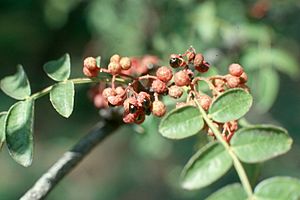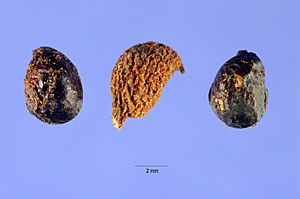Common prickly-ash facts for kids
Quick facts for kids Common prickly-ash |
|
|---|---|
 |
|
| Zanthoxylum americanum at the Real Jardín Botánico de Madrid | |
| Conservation status | |
| Scientific classification | |
| Genus: |
Zanthoxylum
|
| Species: |
americanum
|
 |
|
| Natural range | |
| Synonyms | |
|
|
The common prickly-ash, also known as the northern prickly-ash, is a cool plant! Its scientific name is Zanthoxylum americanum. People sometimes call it the toothache tree because of how it was used in the past. It's a shrub or small tree that smells nice.
You can find this plant growing in the central and eastern parts of the United States and Canada. It's the northernmost type of plant in the Rutaceae family, which is the same family that includes citrus fruits like oranges and lemons! This plant can grow up to 10 meters (33 ft) tall. Its trunk can be about 15 cm (5.9 in) wide.
The common prickly-ash has thin leaflets and its flowers grow in clusters near the leaf axils (where the leaf meets the stem). The wood isn't used much for building. However, people have used oils from its bark in traditional medicine. Scientists are also studying these oils to see if they have properties that fight fungi or certain cells.
Contents
What's in a Name?
The common prickly-ash has a few different names. Sometimes, another plant called Zanthoxylum parvum (Shinners' tickletongue) is thought to be a special kind of Zanthoxylum americanum.
A Scottish botanist named Philip Miller first described this plant in 1768. He wrote about it in his book, The Gardeners Dictionary. He mentioned that it grew naturally in places like Pennsylvania and Maryland. This plant is the main example for its whole group, or genus, called Zanthoxylum. This genus includes many plants with leaves that smell good.
How to Spot a Prickly-Ash
This plant has leaves made up of 5 to 11 smaller leaflets. The leaves are dark green and have bumpy edges. They also have a bitter, spicy smell. The buds on the plant are a bit fuzzy.
The fruits start green, then turn red, deep blue, and finally black. The flowers are usually yellow-green. They grow in small, umbrella-like clusters. Each flower has 4 or 5 petals and 5 stamens (the parts that make pollen). The fruit is a type of pod called a follicle, and each pod usually has two seeds.
Where It Grows and How It's Doing
The common prickly-ash is more common in the northern parts of the United States. It's found in many states, from Alabama to Wisconsin, and also in Ontario and Quebec, Canada.
However, in some places, it's not doing so well. It's listed as endangered in Florida, Maryland, and New Hampshire. It's also a "special concern" in Tennessee.
Some types of butterfly larvae, like the Thoas swallowtail, giant swallowtail, and spicebush swallowtail, love to eat the leaves of Zanthoxylum americanum. This plant was well-known to the native people of the areas where it grows. An early European plant collector, John Bartram, was one of the first to describe it to others.
Zanthoxylum parvum Details
Where it Lives
Zanthoxylum parvum often grows under maple-oak forests or among small evergreen oak trees. It likes rocky, shallow, well-drained soil, especially on volcanic rock, at high elevations (from 1,350–1,750 metres (4,430–5,740 ft)).
The plants growing beneath these trees are mostly native grasses. There are also some cacti and other small plants. In very shady spots, not much grows on the ground, but there's a thick layer of fallen leaves.
When it Flowers
Zanthoxylum parvum flowers in late March to early April. This happens before its leaves are fully grown. Even though its leaves are around for most of the year, they fall off in mid-October and turn yellow.
Interesting Facts
Zanthoxylum parvum is a rare plant that scientists don't know a lot about. It's only found in a few places in the Davis Mountains.
Prickly-Ash and Medicine
Traditional Uses
For a long time, people have used an oil from the bark and fruits of the common prickly-ash (and a similar plant called Zanthoxylum clava-herculis) in herbal medicine. This oil was thought to be a stimulant. Historically, it was used for things like long-term rheumatism, certain fevers, skin problems, and to "cleanse the blood." It was also used for tummy troubles.
Maud Grieve, a famous herbalist, said that the berries were even more powerful than the bark. She noted they could help with gas and muscle spasms. They were also used as a mild laxative and for indigestion. A liquid extract from the berries was given in small doses. People would chew the bark to help with toothaches. A tea made from the fruits was used for sore throats and to help the body get rid of extra water. Michael Dirr, a plant expert, mentioned that Native Americans would chew the stems and fruits to ease toothaches because the plant's strong juice had a numbing effect.
Modern Discoveries
Today, scientists are studying the chemicals in the oil from the common prickly-ash. They are looking into how these chemicals might fight fungi and affect certain cells.
In 2012, a company in Pennsylvania made a type of bitters (a strong, flavored liquid) called Bartram's Bitters. They used prickly-ash bark as one of the ingredients. This recipe was found in a book that belonged to the family of the botanist John Bartram.
Images for kids
-
Zanthoxylum americanum at the Real Jardín Botánico de Madrid
See also
 In Spanish: Zanthoxylum americanum para niños
In Spanish: Zanthoxylum americanum para niños








